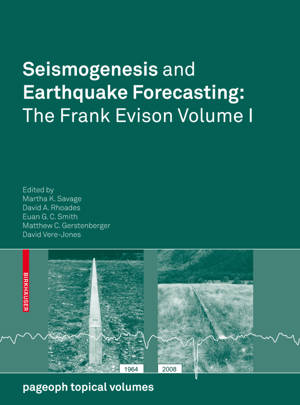
- Afhalen na 1 uur in een winkel met voorraad
- Gratis thuislevering in België vanaf € 30
- Ruim aanbod met 7 miljoen producten
- Afhalen na 1 uur in een winkel met voorraad
- Gratis thuislevering in België vanaf € 30
- Ruim aanbod met 7 miljoen producten
Zoeken
Seismogenesis and Earthquake Forecasting: The Frank Evison Volume I
€ 52,95
+ 105 punten
Omschrijving
This special issue of Pure and Applied Geophysics is one of two volumes containing an augmented collection of papers originating from the Evison Symposium on Seismogenesis and Earthquake Forecasting held in Wellington, New Zealand, in February 2008. The volumes honor Frank Evison's interest in earthquake generation and forecasting. A biography of Frank Evison and a list of his publications is included, as well as review papers and new research papers in the field. The volume includes papers related to Frank's most abiding interest of precursory earthquake swarms. The research contributions cover a range of current forecasting methods such as the Epidemic-Type Aftershock model, the Every Earthquake a precursor According to Scale model, Pattern Informatics, Reverse Tracing of Precursors, stochastic models of elastic rebound, and methods for handling multiple precursors. The methods considered employ a variety of statistical approaches to using previous seismicity to forecast future earthquakes, including regional and global earthquake likelihood models and alarm-type forecasts. The forecast time-frames of interest range from the short time-frame associated with clustering of aftershocks to the long time-frame associated with recurrence of major earthquakes. A recurring theme is the assessment of forecasting performance, whether by likelihood scores, skill scores, error diagrams, or relative operating characteristic tests. The volume will be useful to students and professional researchers who are interested in the earthquake preparation process and in converting that understanding into forecasts of earthquake occurrence.
Specificaties
Betrokkenen
- Uitgeverij:
Inhoud
- Aantal bladzijden:
- 250
- Taal:
- Engels
- Reeks:
Eigenschappen
- Productcode (EAN):
- 9783034604970
- Verschijningsdatum:
- 11/08/2010
- Uitvoering:
- Paperback
- Formaat:
- Trade paperback (VS)
- Afmetingen:
- 190 mm x 257 mm
- Gewicht:
- 498 g

Alleen bij Standaard Boekhandel
+ 105 punten op je klantenkaart van Standaard Boekhandel
Beoordelingen
We publiceren alleen reviews die voldoen aan de voorwaarden voor reviews. Bekijk onze voorwaarden voor reviews.










